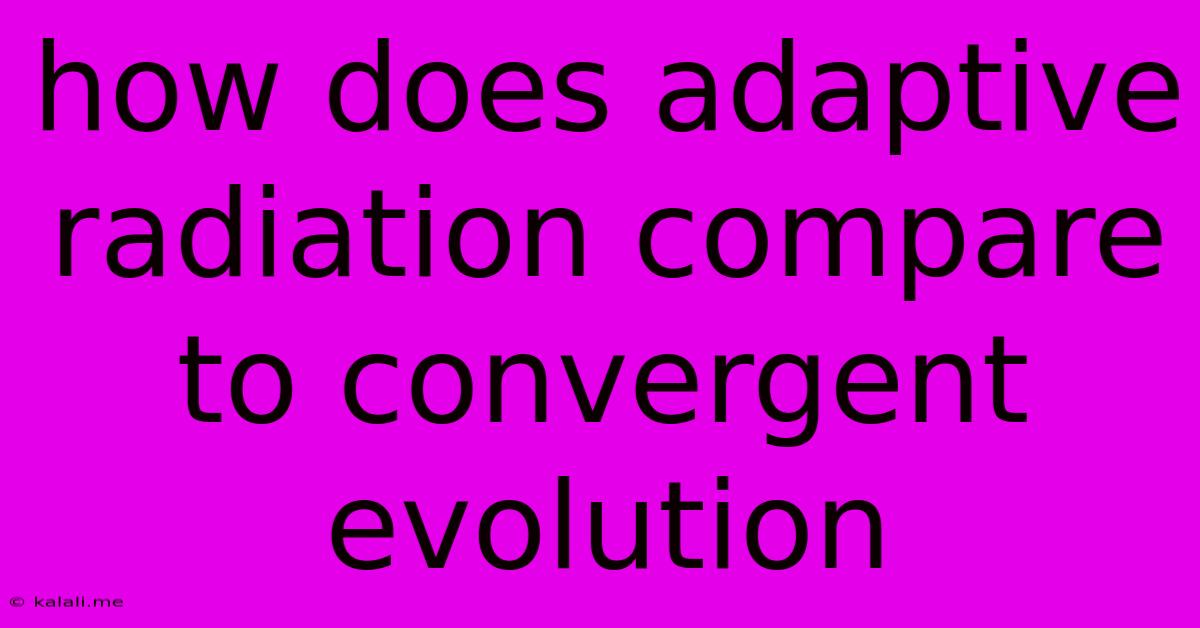How Does Adaptive Radiation Compare To Convergent Evolution
Kalali
Jun 13, 2025 · 3 min read

Table of Contents
Adaptive Radiation vs. Convergent Evolution: A Tale of Two Evolutionary Paths
Understanding the processes that shape life on Earth requires grasping the nuances of evolutionary mechanisms. Two prominent processes, adaptive radiation and convergent evolution, often cause confusion due to their superficially similar outcomes: the emergence of diverse species or similar traits. However, their underlying mechanisms are distinct. This article will delve into the core differences between adaptive radiation and convergent evolution, illustrating them with examples and highlighting their significance in understanding biodiversity.
What is Adaptive Radiation?
Adaptive radiation describes the rapid diversification of a single ancestral lineage into a multitude of species, each adapted to a distinct ecological niche. This burst of speciation is typically triggered by a key innovation (a novel trait conferring a significant selective advantage), the colonization of a new environment with available resources, or the extinction of competitors, opening up ecological opportunities. The resulting species often exhibit significant morphological, physiological, and behavioral differences, reflecting their adaptation to diverse ecological roles.
Key Characteristics of Adaptive Radiation:
- Common Ancestry: All radiating species share a recent common ancestor.
- Rapid Diversification: Speciation occurs at an accelerated pace compared to background rates.
- Ecological Diversification: Daughter species occupy different ecological niches, minimizing competition.
- Morphological Divergence: Species often exhibit significant differences in form and function.
Examples of Adaptive Radiation:
- Darwin's finches: These birds on the Galapagos Islands diversified into numerous species with beaks adapted to various food sources.
- Cichlid fishes in the African Great Lakes: These fish have radiated into hundreds of species with diverse feeding strategies and morphologies.
- Hawaiian silverswords: This plant lineage has diversified into a wide range of forms adapted to various habitats on the Hawaiian Islands.
What is Convergent Evolution?
Convergent evolution describes the independent evolution of similar traits in unrelated lineages. This occurs when species face similar environmental pressures or selective forces. They may occupy similar niches or experience analogous challenges, leading to the development of analogous structures – structures that have similar functions but different evolutionary origins. It's important to note that convergent evolution does not imply a shared ancestry between the species exhibiting similar traits.
Key Characteristics of Convergent Evolution:
- Independent Evolution: Similar traits evolve in unrelated lineages.
- Analogous Structures: Similar structures arise from different ancestral features.
- Similar Environments/Selective Pressures: Convergent evolution is often driven by similar environmental challenges.
- No Shared Ancestry: Species exhibiting convergent evolution do not share a recent common ancestor.
Examples of Convergent Evolution:
- The streamlined bodies of dolphins (mammals) and sharks (fish): Both have evolved similar body shapes for efficient movement in water, despite their vastly different evolutionary histories.
- The wings of bats (mammals), birds (birds), and insects (insects): All three have evolved wings for flight, but their wing structures are fundamentally different, reflecting their distinct evolutionary origins.
- Cactus-like plants in different deserts: Similar succulent plants have independently evolved in various arid regions worldwide, each adapting to water scarcity.
Comparing Adaptive Radiation and Convergent Evolution:
| Feature | Adaptive Radiation | Convergent Evolution |
|---|---|---|
| Starting Point | Single ancestral lineage | Multiple, unrelated lineages |
| Driving Force | Key innovation, new environment, extinction of competitors | Similar environmental pressures/selective forces |
| Outcome | Diversification of species within a lineage | Similar traits in unrelated lineages |
| Homology | Homologous structures (shared ancestry) | Analogous structures (different ancestry) |
Conclusion:
Adaptive radiation and convergent evolution are both powerful evolutionary processes shaping biodiversity. Adaptive radiation leads to the diversification of a single lineage, filling various ecological niches, while convergent evolution results in the independent evolution of similar traits in unrelated lineages facing similar selective pressures. Understanding the distinction between these processes is crucial for interpreting the evolutionary history of life and predicting future evolutionary trajectories. Both processes contribute to the remarkable diversity of life we observe today, showcasing the ingenuity and adaptability of life on Earth.
Latest Posts
Latest Posts
-
What Is Square Root Of 800
Jun 14, 2025
-
Which Of The Following Is An Example Of Convection
Jun 14, 2025
-
Which Of The Following Are Identities
Jun 14, 2025
-
Which Statement About Photosynthesis Is Correct
Jun 14, 2025
-
Size Of A Brick In Cm
Jun 14, 2025
Related Post
Thank you for visiting our website which covers about How Does Adaptive Radiation Compare To Convergent Evolution . We hope the information provided has been useful to you. Feel free to contact us if you have any questions or need further assistance. See you next time and don't miss to bookmark.